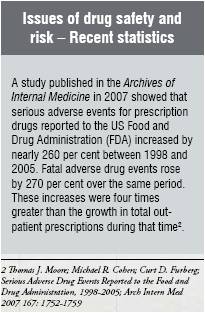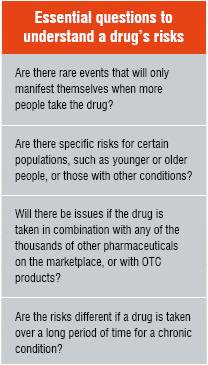A changing regulatory environment and difficult targets present significant challenges for biopharmaceutical companies seeking a balanced approach to risk management.
Risk management for prescription pharmaceuticals is both a high priority and a significant challenge for the biopharmaceutical industry today. Numerous incidents involving the safety and risks of marketed pharmaceutical products in recent years have brought the issue to the forefront of public attention and regulatory scrutiny in the United States, Europe, and elsewhere around the world.
In 2007 alone, nearly a dozen major pharmaceutical products were either withdrawn from the market or placed under stringent prescribing restrictions because of safety concerns. These product failures risked the health of patients, damaged the public trust of both the biopharmaceutical industry and government regulators, and represented investment losses of billions of dollars for the companies involved.
This issue of drug safety and risk is compounded by another significant problem: the inappropriate prescribing of medicines, which is a major cause of adverse drug reactions. For example, one recent study showed that 29 per cent of elderly patients received one or more inappropriate prescriptions medicines. (Simon et al; Journal of the American Geriatric Society, 2005)
Despite these statistics, substantial progress has been made in recent years to reduce risk and improve drug safety within the pharmaceutical industry. Risk management plans are rapidly becoming a prerequisite for regulatory approval outside the US, and are gaining momentum within the FDA as well. However, there is clearly a need for continued investment by pharmaceutical companies to implement proactive, integrated risk management strategies to help ensure that new products provide the appropriate balance between patient benefit and risk. Achieving that balance is particularly difficult in light of the strong public demand for new therapies to address complex, life-threatening conditions such as cancer and Alzheimer’s disease. In addition, the evolving regulatory environment concerning risk management has created its own challenges as a result of the sometimes-conflicting approaches in the US and Europe.

Understanding the challenges
One of the biggest risk management challenges faced by the pharmaceutical industry today is the complexity of the diseases being targeted. Most of the potential treatments for these conditions involve new classes of compounds or new approaches such as biologic and genetic therapies—all of which involve risks that are not fully understood. Many of these diseases are also chronic conditions that impact multiple parts of the body, making the biological effects of any new treatment regimen more difficult to predict.
Added to this challenge is pressure from a competitive global marketplace and a demanding public to bring innovative therapies for these devastating diseases to market as quickly as possible to benefit patients. In addition to concerns regarding recent market withdrawals, public perception of drug safety and risk has also been influenced by growth of drug liability litigation. These pressures require biopharmaceutical companies not only to carefully determine which products to bring to market, but also, importantly, to ensure that they have the right safeguards in place and have developed a proactive, comprehensive safety model and risk management strategy.
The issues of risk and safety must be understood in the context of the clinical trial process. For instance, the largest Phase III clinical trials typically enroll a few thousand patients. These trials provide significant data on the safety and efficacy of the compound for the target indication in its intended population, but it is important to recognise that these studies cannot answer every single question about a product’s risks and side effects.
The key for the biopharmaceutical industry—as well as the public and the regulatory agencies—is to learn as much as possible about the risks of each product within a reasonable period of time, then make a market decision about the product that carefully weighs its benefits compared with its risks.
One step that many pharmaceutical companies are taking in order to enhance their understanding of product benefits versus risks is to expand their clinical trial programmes during the peri-approval process. This is done by continuing to gather important safety and efficacy data during the time after a product has been submitted to a regulatory agency for review. This allows a company to gain additional data about a product and work with the agency during the review process to refine a product’s safety profile and understand its risks more thoroughly. This process helps the agency and the company to agree on product labelling that reflects the appropriate level of risk.
Post-marketing pharmacovigilance programmes also play a vital risk management role. These programmes typically monitor the use of a product in a larger population and gather data on reported adverse events to ensure that a product’s benefit / risk profile remains acceptable, or if changes need to be made to better manage its use. Education programmes for healthcare professionals about proper prescribing criteria are another important way that pharmacovigilance programmes help maintain safe product usage.

Regulatory challenges
While the regulations governing risk management are crucial to ensuring the safety of marketed pharmaceutical products, they also present a challenge to the biopharmaceutical industry as it tries to manage risk on a global scale. The FDA and the European Medicines Agency (EMEA) are leading the way in actively promoting improved drug safety by providing a framework of laws and regulations designed to help companies better manage the risk of their products throughout their lifecycles.
The challenge comes from the on-going evolution of these regulations. Although both the FDA and the EMEA are trying to achieve the same basic goals—protecting public health through better risk management of biopharmaceutical products—they have taken somewhat different approaches. While the regulations are beneficial in many ways, they also can make compliance more difficult and more costly for the biopharmaceutical industry.
Since 2005, the FDA has produced guidances on Premarketing Risk Assessment, the Development and Use of Risk Minimisation Action Plans (RiskMAP), and Good Pharmacovigilance Practices. The guidances stress the importance of early risk assessment and risk minimisation, with an emphasis on uncovering safety issues during clinical trials and providing adequate safety data to the agency to evaluate risk-benefit of drugs submitted for approval. However, as regulations are still evolving, so are their practical applications within the FDA’s divisions, with each division having a somewhat different approach than the other. As a result, risk management planning by biopharmaceutical companies must currently be pursued on a case-by-case basis.
The EMEA has also issued guidelines on risk management systems, a template for a European Union Risk Management Plan (EU-RMP), and new regulations governing pharmacovigilance. The EMEA accentuates the importance of having pharmacovigilance systems in place, and mandates the creation of the position of Qualified Person for Pharmacovigilance (QPPV) to be responsible for a company’s pharmacovigilance efforts for marketed products. Much of the emphasis is placed on databases and reporting systems, especially for post-marketing. Unfortunately, in spite of having all these pan-European guidelines before them, different EU Member States have taken varying approaches to the collection and reporting of safety data.
For biopharmaceutical companies developing products for the global market, these varying standards mean that risk management planning in the near term remains a complex undertaking that must be discussed in close consultation with individual regulatory agencies for every product—making the current process more costly and cumbersome. Although the International Conference on Harmonisation (ICH) has also issued a guidance on pharmacovigilance, more work needs to be done between the industry and regulatory agencies to make the risk management process more transparent and predictable on a global scale.
Meeting the challenges
Given these numerous challenges, what steps should biopharmaceutical companies take to improve global risk management?
• Emphasise risk management and safety planning throughout the product development process – Effective risk management goes far beyond the development of the formal risk management plans that are now becoming standard for regulatory submissions. The evaluation of safety and risk should begin at the earliest stages of development and carry through the entire product lifecycle. Understanding product risks early in the development process would facilitate better management of risk of product for an appropriate target indication and population—without impeding innovation.
• Create a company-wide, proactive “safety culture” – Establish improved safety and risk management as corporate priorities that are integrated into every decision and every part of the company values for which all levels of the company are held responsible. Invest in the people, processes, and technology needed to improve risk management and protect the company’s most important assets: its products.
• Use peri-approval trials to gain safety data – Make greater use of clinical trials conducted during the pre-approval periods to gain additional information on product safety and risk in potential target populations, and to refine the product’s risk profile.
• Work closely with regulatory agencies on safety issues – With the evolving regulatory landscape, companies should discuss risk management issues with the appropriate agency officials during the pre-submission period to foster greater understanding about a product’s risk factors and gain the agency’s insight into potential requirements for safety data or formal risk management plans.
• Continue to promote regulatory harmonisation – The biopharmaceutical industry needs to continue to work with global regulatory agencies and the ICH to bring greater consistency and predictability to risk management planning at a global level.
• Support awareness programmes for appropriate prescribing and usage – Although a product’s labelling spells out the approved indication and usage guidelines, the statistics concerning inappropriate use of prescriptions drugs show that more needs to be done to educate healthcare professionals and the public about the proper use of each new drug that reaches the market. Such programmes help avoid undue risk, while maintaining access to new therapies for those who need them.
Particularly for stakeholders in the prescription drug arena—pharmaceutical companies, regulatory agencies, healthcare providers, and patients—the most important goal is to bring safe, efficacious medicines to market with the appropriate benefit / risk ratio as quickly as possible, and to keep those products available to help those who need them. Achieving that goal, however, means that risk management must be viewed as a continual process of understanding and reducing risk.
Within the biopharmaceutical industry, the key to responsible risk management is to understand the risks of a product as much as possible before it reaches the market, and manage those risks once the product is launched in the market. That means investing in and promoting safety and risk management throughout the product development process. While that investment can be costly, it pales in comparison to the cost of taking a product through development, only to have it fail to be approved or be withdrawn from the market because of safety issues.
Whether it is through better education of physicians and patients about appropriate product use, a reduction in adverse events, elimination of product withdrawals, or other safety improvements, a company with a proactive approach to safety and risk management will reap competitive benefits. Additionally, the company will enhance its reputation among patients, regulators, lawmakers, physicians, insurers, and the many other important constituencies. And, this brand image ultimately determines the success of a company in the healthcare field. But, most importantly, companies that have a proactive approach to safety and risk management will be able to more positively contribute to bringing safe and effective treatments to patients worldwide, and keeping these products in the market.